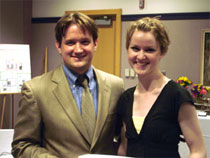 Alexandra Reekie
Alexandra Reekie
Self-identity in the Myspace Age
The internet has morphed from a tool of connection and communication between people and locations into a substitute for physical space itself. The virtual communities of cyberspace once consisted of MUDs, worlds in which the user assumed a character and moved through a fantasy reality. Increasingly, however, social networking sites are becoming more prevalent, allowing users to place their supposed "real" selves into cyberspace. These sites, like Myspace, blur the boundaries between the real and the virtual, as people begin to define themselves and others in terms of the information that they place onto a computer screen. As Erving Goffman claimed in his book, The Presentation of Self in Everyday Life, an individual performs his or her identity through social signifiers, which can either lead or mislead others. This same notion that Goffman applied in 1959 still holds in the age of Myspace, when people define their identities through online profiles. What implications does this virtual social establishment have on the notion of the self? Are the profiles created on social networking sites really any different from the characters undertaken in virtual worlds such as MUDs? Finally, how does this extension of the self onto an internet webpage alter the concept of social interaction?
